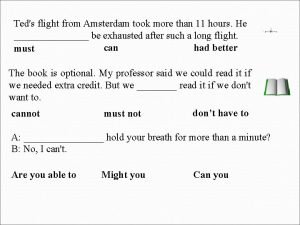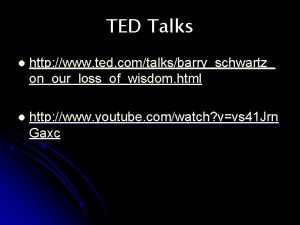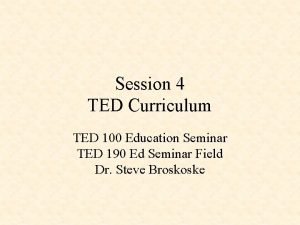Chapter 2 Lesson 2 http ed ted comlessonsjoshuamanleynewtons3

















- Slides: 17

Chapter 2 – Lesson 2 http: //ed. ted. com/lessons/joshua-manleynewton-s-3 -laws-with-a-bicycle

Newton’s 1 st Law An object at rest tends to stay at rest and an object in motion tends to stay in motion unless acted upon by an unbalanced force.

Part 1: An Object at Rest Identify an object at rest Ex: chair on the floor, a plane on a runway These objects will not start moving until a push or pull is exerted on them. Ex: You tend to fall backward when your school bus starts to move.

Part 2: An Object in Motion An object moving at a certain velocity will continue to move forever at the same speed and in the same direction unless some unbalanced force acts on it. Ex: Riding in your car. When your mother or father comes to a stop then you would continue to move, however your seatbelt stops you. http: //www. physicsclassroom. com/mmedia/newtlaws/il. cfm

Balanced Force Equal forces in opposite directions produce no motion

Unbalanced Force Unequal opposing forces produce an unbalanced force causing motion

If objects in motion tend to stay in motion, why don’t moving objects keep moving forever? Things don’t keep moving forever because there’s almost always an unbalanced force acting upon them. A book sliding across a table slows down and stops because of the force of friction If you throw a ball upwards it will eventually slow down and fall because of the force of gravity

Inertia The tendency of an object to resist a change in its motion Inertia can be described as the tendency of an object to keep doing whatever’s it’s doing.

Inertia is the reason objects at rest remain at rest and objects in motion remain in motion Inertia is the reason you slide toward the side of a car when the driver makes a sharp turn.

MASS and INERTIA The more MASS an object has, the more INERTIA the object has. Therefore an object with a small mass will have a SMALL inertia And an object with a large mass will have a LARGE inertia. Bigger objects are HARDER to start & stop Which vehicle has more inertia?

Inertia

The truck is in motion. What is the force that causes it to stop? The push of the stopped car. The car is at rest. What is the force that causes it to move? The push of the truck.

Group Work! In your group take 3 MINUTES to come up with an example of Newton’s 1 st Law in everyday life. Be ready to explain using the proper vocabulary.

Assess Your Knowledge If gravity between the Sun and Earth suddenly vanished how would Earth move? Answer: In a straight path

To say that 1 kg of matter weighs 10 N is to say that 1 kg of matter a. Will weigh 10 N everywhere b. Has less volume than 10 kg of matter c. Has more inertia than 10 kg of matter d. Is attracted to Earth with 10 N of force Answer: D

If the net force on an object is zero then the object has a. Balanced forces b. Action forces c. Reaction forces d. Unbalanced forces Answer: A

The greater the mass of an object, a. The easier the object starts moving b. The more space the object takes up c. The greater its inertia d. The more balanced it is Answer: C
 Https://ed.ted.com/lessons/the-wacky-history-of-cell-theory
Https://ed.ted.com/lessons/the-wacky-history-of-cell-theory Http //mbs.meb.gov.tr/ http //www.alantercihleri.com
Http //mbs.meb.gov.tr/ http //www.alantercihleri.com Http //siat.ung.ac.id atau http //pmb.ung.ac.id
Http //siat.ung.ac.id atau http //pmb.ung.ac.id The iron man ted hughes chapter 3
The iron man ted hughes chapter 3 An overall state of well-being or total health
An overall state of well-being or total health Tom hughes poet
Tom hughes poet Tualatin high school schedule
Tualatin high school schedule Ted talk script examples
Ted talk script examples Ted hughes the jaguar
Ted hughes the jaguar The apes yawn and adore their fleas in the sun.
The apes yawn and adore their fleas in the sun. Tianshu meat vs moon pie
Tianshu meat vs moon pie Corinna betsch
Corinna betsch Ted talks susan cain
Ted talks susan cain Tara koppel
Tara koppel Ted hudson burnbrae farms
Ted hudson burnbrae farms Ted harrison northern lights
Ted harrison northern lights Sixth sense technology documentation
Sixth sense technology documentation Christian bale ted bundy
Christian bale ted bundy































